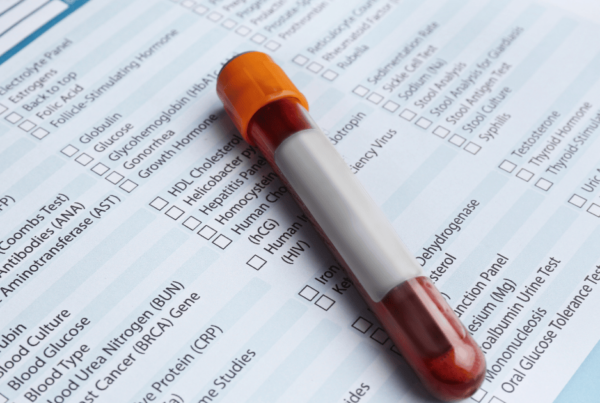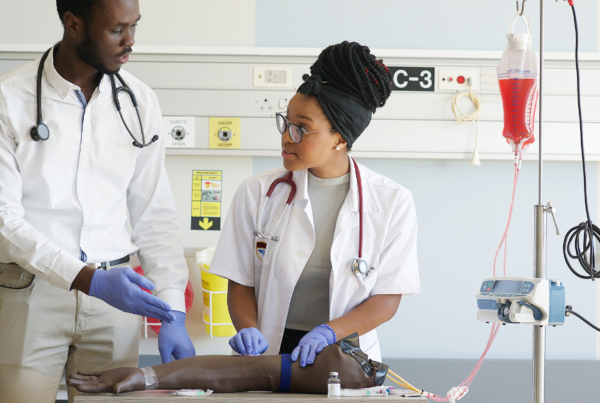Becoming a phlebotomist is a rewarding career choice for those interested in the medical field. One common question among aspiring phlebotomists is, “Do you need math to become a phlebotomist?” In this blog post, we’ll look at the role of math in phlebotomy, what abilities are required, and how to prepare for this vocation.
| Key Takeaways |
| Basic math skills are essential for phlebotomists, but advanced math is not required. |
| Important math skills include basic arithmetic, unit conversion, ratios and proportions, and understanding fractions and decimals. |
| Phlebotomists use math in tasks like calculating blood volumes, managing inventory, and accurate record-keeping. |
| Proper education and training, including a high school diploma, phlebotomy training program, and certification, are crucial for becoming a successful phlebotomist. |
| Regular practice, seeking support, and applying math in real-life scenarios can help build confidence in math skills. |
Understanding the Role of a Phlebotomist
Before diving into the specifics of math in phlebotomy, it’s important to understand what a phlebotomist does. Phlebotomists are healthcare professionals trained to draw blood from patients for various purposes, including medical testing, transfusions, donations, and research. Their duties also include maintaining equipment, keeping records, and ensuring patient comfort and safety during the procedure.
Phlebotomists play a crucial role in the healthcare system, serving as a bridge between patients and the medical data needed for accurate diagnosis and treatment. The blood samples they collect are essential for a wide range of medical tests that help doctors diagnose conditions, monitor health status, and determine the effectiveness of treatments.
Do You Need Math to Become a Phlebotomist?
The straightforward answer to the question, “Do you need math to become a phlebotomist?” is yes, but only to a limited extent. Phlebotomists do not need advanced mathematical skills, but a basic understanding of math is essential. Here’s why:
- Calculating Blood Volume: Phlebotomists need to calculate the correct amount of blood to draw based on the tests ordered by the physician. This requires basic math skills to ensure accuracy and patient safety. Drawing too much or too little blood can affect test results and patient well-being. Therefore, understanding the answer to “Do you need math to become a phlebotomist?” is crucial for proper blood volume calculations.
- Understanding Measurements: Phlebotomists must understand different measurement units, such as milliliters and liters, to accurately draw and measure blood samples. This is crucial for ensuring that the samples meet the required volumes for various tests. So, knowing “Do you need math to become a phlebotomist?” helps in handling measurements effectively.
- Inventory Management: Managing supplies and keeping track of inventory involves simple arithmetic to ensure that there are always enough materials on hand. Phlebotomists need to track the usage of needles, syringes, vials, and other supplies to avoid shortages that could disrupt their work. Understanding the role of math in inventory management answers the question of “Do you need math to become a phlebotomist?”
- Data Entry and Record Keeping: Accurate data entry often involves basic math to record the number of samples taken, label vials correctly, and maintain patient records. Phlebotomists must ensure that all information is recorded accurately to prevent errors that could lead to misdiagnosis or other issues. Hence, the question “Do you need math to become a phlebotomist?” extends to data handling as well.
Essential Math Skills for Phlebotomists
While you don’t need to be a math expert to become a phlebotomist, certain basic math skills are essential. Here are some of the key areas where math is used in phlebotomy:
- Basic Arithmetic: The fundamental operations are addition, subtraction, multiplication, and division. These skills are used for tasks like calculating dosages, managing supplies, and handling billing and coding. Phlebotomists often need to perform quick calculations to ensure they are drawing the correct amount of blood or preparing solutions accurately. This highlights why knowing “Do you need math to become a phlebotomist?” is important for daily tasks.
- Unit Conversion: Understanding how to convert between different units of measurement, such as converting milliliters to liters, is crucial. This skill is important for ensuring that the correct volumes are used in blood collection and for accurately mixing solutions used in laboratory tests. The answer to “Do you need math to become a phlebotomist?” involves understanding unit conversions.
- Ratios and Proportions: These are important for mixing solutions and understanding concentration levels in blood samples. Phlebotomists may need to dilute samples or prepare reagents, and understanding ratios ensures that these tasks are performed correctly. Knowing “Do you need math to become a phlebotomist?” includes grasping ratios and proportions.
- Fractions and Decimals: Used in various calculations, such as determining the correct volume of blood to be drawn. Phlebotomists often work with fractional volumes and need to be comfortable converting between fractions and decimals to ensure accuracy. This demonstrates the importance of understanding “Do you need math to become a phlebotomist?”
Preparing for a Career in Phlebotomy
Now that we’ve established that math is a necessary part of phlebotomy, let’s discuss how you can prepare for this career.
1. High School Education
A high school diploma or equivalent is the minimum educational requirement for becoming a phlebotomist. During high school, focus on courses like biology, chemistry, and math. These subjects will provide a solid foundation for your phlebotomy training. Courses in health science and anatomy can also be beneficial. Addressing the question “Do you need math to become a phlebotomist?” starts with a strong educational background.
2. Phlebotomy Training Program
Enroll in a training program for phlebotomy that has been approved by a reputable body, such the National Accrediting Agency for Clinical Laboratory Sciences (NAACLS). These programs typically include coursework in anatomy, physiology, medical terminology, and basic math. Hands-on training in blood collection techniques is also a key component of these programs. Look for programs that offer extensive clinical practice, as this hands-on experience is invaluable. Understanding “Do you need math to become a phlebotomist?” will help you choose the right training program.
3. Certification
While not all states require certification, becoming a certified phlebotomist can enhance your job prospects and credibility. Organizations like the American Society for Clinical Pathology (ASCP) and the National Phlebotomy Association (NPA) offer certification exams. Preparing for these exams often involves reviewing math skills relevant to the field. Certification demonstrates to employers that you have met a standard of knowledge and competence in phlebotomy, reinforcing why “Do you need math to become a phlebotomist?” is a crucial consideration.
4. Continuing Education
Healthcare is an ever-evolving field, and staying updated on the latest techniques and practices is crucial. Continuing education courses can help you refine your skills and stay current with industry standards. Many certifying organizations require ongoing education to maintain certification, ensuring that phlebotomists remain knowledgeable about the latest developments in their field. Recognizing the importance of continuing education addresses the question “Do you need math to become a phlebotomist?” throughout your career.
The Importance of Math in Phlebotomy Practice
In practice, math is integrated into many aspects of a phlebotomist’s daily duties. For instance, when preparing for a blood draw, phlebotomists need to determine the appropriate size of the collection tube based on the volume of blood required. This involves understanding and applying basic mathematical concepts.
Additionally, phlebotomists must often calculate the total blood volume they can safely draw from a patient, especially if multiple tests are ordered. This requires knowledge of blood volume guidelines and the ability to perform quick calculations to ensure patient safety. The answer to “Do you need math to become a phlebotomist?” is evident in these practical applications.
Inventory management is another area where math skills are crucial. Phlebotomists must keep accurate records of supplies used and ensure that stock levels are maintained. This involves tracking usage rates, calculating reorder points, and managing budgets effectively.
Common Misconceptions About Math in Phlebotomy
One common misconception is that phlebotomists need advanced math skills to succeed. This is not true. While a basic understanding of math is necessary, advanced mathematical knowledge is not required. Most of the math used in phlebotomy involves simple arithmetic and unit conversions, which can be easily learned and applied with practice.
Another misconception is that phlebotomy training programs require extensive math coursework. In reality, the math component of phlebotomy training is relatively small and focused on practical applications. The primary emphasis is on developing proficiency in blood collection techniques and understanding the clinical aspects of the job.
Building Confidence in Math Skills
For those who may feel intimidated by the prospect of using math in their phlebotomy career, there are several ways to build confidence and improve skills:
- Practice Regularly: Regular practice of basic math skills can help reinforce knowledge and improve accuracy. There are many online resources and apps available that offer math practice tailored to healthcare professionals.
- Seek Support: If you struggle with certain math concepts, seek support from instructors, classmates, or online forums. Many phlebotomy training programs offer tutoring or additional resources to help students succeed.
- Apply Math in Real-Life Scenarios: Applying math skills in real-life scenarios can make learning more relevant and practical. For example, practice calculating blood volumes based on different test requirements or managing an inventory of supplies.
- Use Tools and Resources: There are many tools and resources available to assist with math calculations in phlebotomy. Calculators, conversion charts, and reference guides can help ensure accuracy and build confidence.
FAQs
Is advanced math required to become a phlebotomist?
No, advanced math is not required. However, basic math skills are essential for tasks such as calculating blood volumes, managing inventory, and keeping accurate records.
What basic math skills do phlebotomists need?
Phlebotomists need skills in basic arithmetic (addition, subtraction, multiplication, and division), unit conversion, ratios and proportions, and understanding fractions and decimals.
Can I become a phlebotomist without a high school diploma?
A high school diploma or equivalent is the minimum educational requirement for becoming a phlebotomist. It’s important to focus on courses like biology, chemistry, and math during high school.
Do all states require phlebotomists to be certified?
Not all states require certification, but becoming a certified phlebotomist can enhance your job prospects and credibility. Certification from reputable organizations like the American Society for Clinical Pathology (ASCP) or the National Phlebotomy Association (NPA) is valuable.
How can I prepare for the math involved in phlebotomy?
You can prepare by focusing on relevant courses in high school, enrolling in a phlebotomy training program, and practicing basic math skills. Continuing education can also help refine your skills. Utilize online resources, calculators, and conversion charts to support your learning and application of math in practical scenarios.
Conclusion: Do You Need Math to Become a Phlebotomist?
In conclusion, while advanced math is not a requirement, basic math skills are indeed necessary to become a competent and effective phlebotomist. These skills are used in various aspects of the job, from calculating blood volumes to managing inventory. By preparing through proper education and training, aspiring phlebotomists can develop the necessary math skills and excel in their careers.
Phlebotomy is a field that combines technical skills with compassionate patient care. The ability to perform accurate measurements and calculations ensures that blood draws are conducted safely and efficiently. With a solid foundation in basic math, you can confidently handle the responsibilities of a phlebotomist and contribute to the healthcare system effectively.
Ready to Start Your Phlebotomy Career?
Phlebotomy Now School offers comprehensive training programs designed to equip you with the knowledge and skills needed to succeed as a phlebotomist. Our expert instructors provide hands-on training and practical experience to ensure you are well-prepared for the challenges and rewards of this important healthcare role.
Ready to Start Your Phlebotomy Career?
Phlebotomy Now School offers comprehensive training programs designed to equip you with the knowledge and skills needed to succeed as a phlebotomist.
Our expert instructors provide hands-on training and practical experience to ensure you are well-prepared for the challenges and rewards of this important healthcare role.


